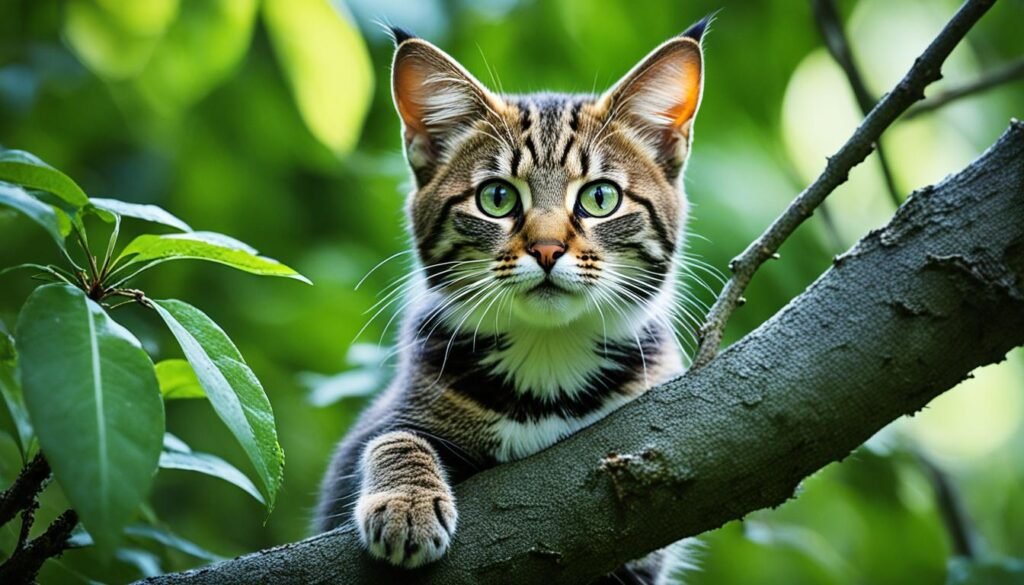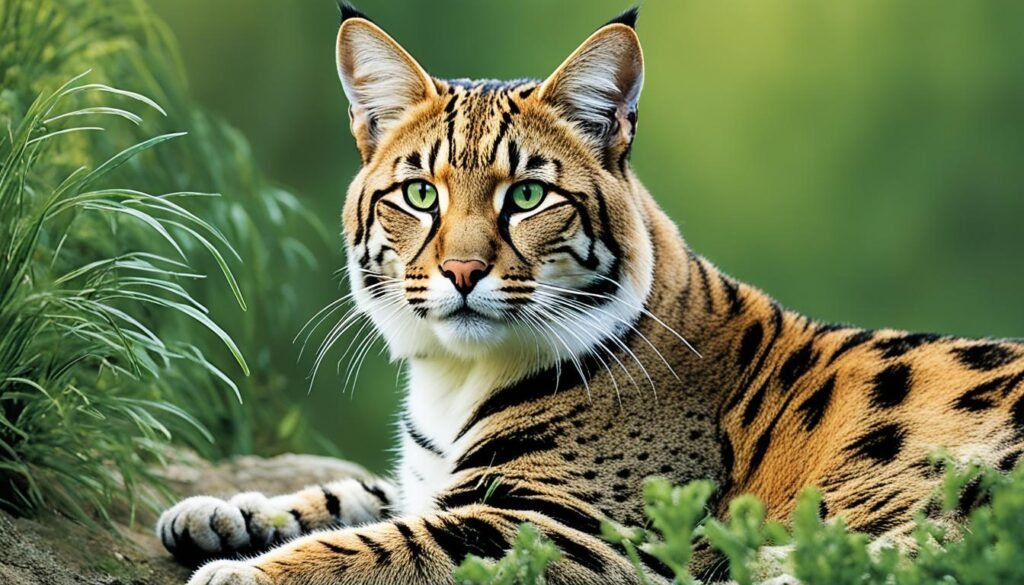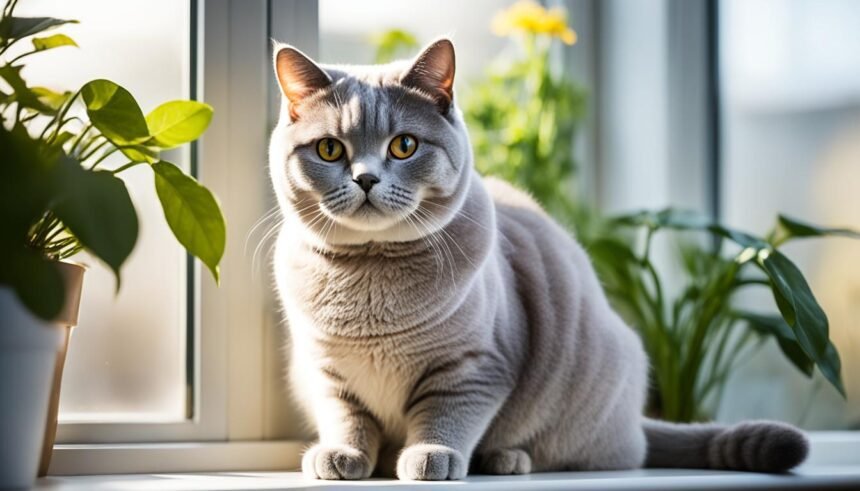In the vast world of animals, the Felidae family fascinates us with a wide range of felines. This includes majestic big cats like lions and tigers. It also covers smaller, lesser-known wild cats across the globe. There are over 40 cat species, each with unique traits and adaptations.
These remarkable creatures have won the hearts of many throughout history. Even the common domestic cat is part of this extraordinary family. They share a link with their wild relatives from the past.
We explore the world of these amazing animals and learn about their hunting skills. The tiger stands out as the largest wild cat. Meanwhile, the Iberian lynx has fought back from nearly disappearing. The Pallas’s cat adapts to cold temperatures beautifully. And the Fishing Cat has impressive skills in the water.
Through their stories, we see why it is crucial to protect these animals. Their survival is key to the health of our planet. Each cat species plays an important role in nature’s balance.
The Diversity of Felidae: Exploring the Big Cat Lineage
When we look into the world of Felidae, it’s key we grasp the history of its largest members: the big cats. These large predators belong to the Pantherinae subfamily. They stand as a powerful wild emblem and show the complexity and variety of nature.
Defining “Big Cats”: Distinguishing Features of Pantherinae
The Pantherinae group includes incredible animals like the Siberian tiger and the Asiatic lion. They’re known for their strong bodies, loud roars, and noble ways. These big cats link back around 25 million years through evolution. They have evolved unique features, like the lion’s powerful bite and the leopard’s sharp night vision. This shows nature’s skill in crafting these survivors.
Conservation Status: Threats to Big Cat Species
The beauty of these large carnivores comes with a serious caution. Their conservation status is alarming. The Siberian tiger, the endangered Amur leopard, and others are threatened by human activities, habitat loss, and illegal hunting. These issues highlight how humans greatly affect natural habitats. Thus, saving these species is vital for keeping nature balanced.
Spotlight on Endangered Titans: The Plight of the Tiger and the Asiatic Lion
The endangered species like the mighty Siberian tiger and the scarce Asiatic lion are in a critical state. Their decline is not just about biology but also the fading of our planet’s natural legacy. Lions, being very social, work together in groups. We need to collaborate globally to save these majestic animals.
| Species | Weight Range (males) | Weight Range (females) | Conservation Status |
|---|---|---|---|
| Siberian Tiger | 400 to 600 pounds | 300 to 350 pounds | Endangered |
| Asiatic Lion | 300 to 500 pounds | Endangered | |
| Amur Leopard | 70 to 105 pounds | 55 to 94 pounds | Critically Endangered |
To keep our big cats safe, we need to intensify conservation efforts. Protecting their habitats and fighting poaching are critical. Through global teamwork, we can secure a safer future for species like the Siberian tiger and Asiatic lion. This will let them continue symbolizing the strength and beauty of the wild.
Spotlight on Small Wild Cats: The Lesser-Known Felinae Members

Large cats often get all the fame, but the planet also shelters many small wild cats. These little felines, all 33 species of them, are part of the Felinae family. They are mighty hunters and survivors, perfectly suited to their environments. Yet, they face major risks like losing their homes and illegal trade, making them endangered felids in need of our help.
Adaptable Predators: Lynxes and Ocelots in the Wild
Lynxes are amazing for their ability to live in different places, from cold boreal forests to mountains where Iberian lynxes are found. Thanks to intense conservation work, lynx numbers are now growing, which is great news. Ocelots, with their beautiful coats, also adapt well. However, they live in rainforests and are hunted for their fur, making them vulnerable.
Elusive and Rare: Andean Mountain Cat and Bay Cat
The Andean mountain cat and bay cat are extremely hard to find and protect. They live in hard-to-reach places like the high Andes and Borneo’s forests. The Andean mountain cat, especially, is critically endangered due to hunting and losing its home.
Studying and saving these small cats is not just fascinating but also vital for nature. They help keep the environment balanced. However, saving small wild cats is tough because they get very little money compared to big cats. Despite this, groups like Panthera are working hard to save them worldwide.
- The flat-headed cat and black-footed cat show the variety among small wild cats. The first is one of the tiniest, and the second has an impressive hunting record.
- Asia is key for saving small cats. Efforts there include using less palm oil to save critical habitats.
- It’s crucial to look after smaller, less-known cats like ocelots and lynxes, along with endangered felids. This helps keep our planet rich and diverse.
For these small wild cats to survive, it takes global cooperation—from money to action. This collective effort is what will ensure their future.
Felidae’s Secretive Solitary Hunters: Analyzing Hunting Behavior and Territory
In the Felidae family, cats are master hunters who control their land with precision. Their hunting skills show the art of being alone but effective. This knowledge helps us protect them.
Stalking and Pouncing: Energy Efficiency in the Wild
Cats are natural lone hunters, perfecting their craft over time. They quietly stalk their prey, saving energy until the perfect moment. Finally, they pounce, using their energy wisely. House cats act out these behaviors, just in a less serious way.
Predatory Tactics: The Diverse Hunting Methods of Felines
While most cats hunt alone, they also have different tactics. For example, cougars have a social structure that affects how they hunt together. Studies show how cougars share meals, revealing much about their social life.
With millions of domestic cats, we wonder about hunting and resource availability. Studying how many cats can live in one area is important for wild and home settings.
Research on house cats shows that sharing improves their interactions. A study on cougars from 2012 to 2015 found many interactions at food sites. This shows how vital territory is in their social life.
However, when too many cats live close together, problems happen. This can lead to health issues and behavior changes. Understanding these issues helps us see how cats adapt and manage their energy.
Understanding Wild Cat Communication: From Roars to Purrs

Wild cats do more than just “meow” like our house cats. They use a variety of sounds, from loud roars to gentle purrs. These sounds help them survive and connect with each other.
Lions have the loudest roar, which can be heard up to five miles away. This roar, as loud as a chainsaw, helps them keep their territory and bond with their group. They use special vocal folds to make these powerful sounds.
In the Panthera group, which includes lions, leopards, tigers, and jaguars, roars are unique. Leopards, for example, can “saw” across two miles. But unlike smaller cats, these big cats can’t purr because of their vocal box structure.
Cheetahs, the fastest land animals, use growls, bleats, and chirps to talk. They mark their area with smell. They can purr, making them similar to house cats in some ways.
Wild cats in places like Southern Africa use different sounds for various reasons. Seeing them in places like Botswana and Namibia helps us understand their world better.
- Lions show love with growls and gurgles, kind of like purring.
- Leopards roar to reach others over long distances.
- Cheetahs use sounds and smells to talk to each other.
But cats don’t just use sounds to communicate. Touching, smells, and certain actions also send messages. This helps avoid fights by making intentions clear.
Actions like ‘allorubbing’ among lions or scratch marks show messages too. Every mark or touch is part of their way to talk to each other.
Seeing these behaviors in the wild is amazing. It shows us how smart and adaptable these animals are. It also shows why we need to protect their homes for future study and admiration.
Examining Wild Cat Habitats: Where Felines Thrive
Wild cat habitats stretch from Connecticut’s forests to Arizona’s mountains. These areas are essential for species like the bobcat and mountain lion. These predators help keep their environments healthy. They also show the wide range of life in North America’s landscapes. It’s key to understand and protect their living spaces to help them and their ecosystems stay alive.
Forests, Grasslands, and Mountains: Diverse Ecosystems of Felidae
The bobcat is North America’s most seen wild cat. It lives in places like dense forests and rocky woodlands in Connecticut. These areas with lots of plants give the bobcat places to hide and hunt. Mountain lions in Arizona live differently, with territories over 100 square miles wide. They roam forests, grasslands, and mountains. This shows why big, connected spaces matter for wild cats’ survival.
Habitat Conservation: Importance for Feline Survival
Protecting habitats is key to saving wild cats. Efforts in Connecticut and Arizona show how important this is. For example, the Pittman-Robertson Program helps study bobcats in Connecticut. This improves what we know and how we protect them. In Arizona, paths help mountain lions move between areas. This shows how linking habitats helps wild cats live on.
Prowess and Adaptability: Physical Attributes of Predatory Cats

Predatory cats from the feline family are perfect examples of evolution at work. Their physical traits have been fine-tuned for millions of years. Today, they stand as some of the most skilled hunters on Earth. From the Siberian tiger in the Russian tundra to the tiny black-footed cat in dry lands, every cat has special features. These features help them survive in their own habitats.
Cats are known for their agility, which is crucial for their survival. This agility lets them move gracefully and powerfully across their territory. Their bodies are designed for adaptability, giving them an edge in the wild. In this discussion, we will look at the attributes that make these animals top hunters.
The Biggest to the Smallest: Comparing Sizes Among Cat Species
The Felidae family shows a wide range of sizes, related to where they live and how they hunt. The Siberian tiger is the largest, symbolizing power. On the other hand, the tiny black-footed cat uses its small size for sneaky, night-time hunting. This shows how what seems like a weakness can be a strength.
Feline Agility: Evolution of Grace and Power
The way predatory cats move is amazing. Watch a cheetah sprint or a leopard sneak up on its prey, and you’ll see their agility in action. Their speed, strength, and quick reflexes come from centuries of evolution. This makes them some of the most fascinating and dominant predators in the wild.
| Species | Hunting Success Rate | Remarkable Hunting Attribute |
|---|---|---|
| Siberian Tiger | 5–50% | Largest wild cat with immense strength |
| Lion | 54% vs African Buffaloes | Social hunters with tactical team efforts |
| African Wild Dog | Up to 90% | Endurance hunters with coordinated chases |
| Black-footed Cat | 60% | Smallest wild cat with an extremely high kill rate |
| Cougar | Varies widely | Notably high kill rates in females with cubs |
Family Felidae: A Detailed Look at Lifecycle and Reproduction
The Family Felidae highlights a world of lifecycle stages and important reproduction details. These are vital for their survival. Understanding these factors shows us the amazing journey of felines. It takes them from birth, through adulthood, to continuing their family line.
The Circle of Life: Breeding and Offspring Rearing in the Wild
Members of the Family Felidae take part in a repeating circle of breeding and caring for their young in nature. What they eat and where, greatly affect this. It decides how often they reproduce and if their young survive. Some cats rear their young alone, while lions work together.
Such behaviors show their deep instincts to adapt and look after their young. This ensures the survival of these majestic creatures.
Longevity and Survival: Lifespan of Wild Cats in Different Environments
Lifespan in the wild speaks to a cat’s ability to adapt and survive harsh conditions. Many challenges come their way, like finding a home and staying safe from predators. The place they live and other factors combine to showcase a cat’s life story. This story tells of struggles with nature and human impact.
| Characteristic | Average in Domestic Cats | Variation in Felidae Family |
|---|---|---|
| Weight | 2.7 to 4.5 kg (6 to 10 pounds) | 0.9 kg to >300 kg |
| Length | Males: 71.1 cm (28 in) Females: 50.8 cm (20 in) |
Varies with species |
| Purring | Often associated with pleasure/contentment | Behavior noted in domestic cats; specific to contentment or distress |
| Habitat Impact | N/A | Human activity posing threats to natural habitats |
| Gestation | N/A | 56 to 112 days |
| Population Trend | N/A | 29 out of 36 species decreasing |
| Conservation Status | N/A | Nearly 50% classified as threatened |
The complex life, from mating to raising young, is key for the Felidae family. They not only continue their kind but also help nature stay balanced. Yet, their life and survival are not secure. It connects to Earth’s well-being. Studying and understanding these creatures reminds us why we must protect them and their wild homes.
All Types of Felines, Wild Cat: The Complete 41 Species Overview

The world of wild cats is vast, with 41 different species. Each species lives in its own special part of the world. We have big, powerful cats in the Pantherinae group, many types of Felinae, and the more hidden wild cats. Many of these cats are almost gone. We must learn about them to keep them safe.
-
The Andean Mountain Cat is very rare, with less than 2500 left. It’s the most endangered small wild cat in the Americas.
-
The Asian Leopard Cat lives in many Asian areas. This shows how well these cats can adapt to different places.
-
The Black-footed Cat loves dry places. You can find it in the savannahs and semi-deserts of southern Africa.
-
The Iberian Lynx is in danger. Its future is unsure because it mostly eats European rabbits and is on the IUCN Red List.
-
The Jaguar, third biggest in the Pantherinae, lives from Mexico to northern Argentina.
| Felidae Lineage | Number of Species | Notable Species |
|---|---|---|
| Pantherinae | 6 | Jaguar, Lion |
| Felinae | 35 | Andean Mountain Cat, Iberian Lynx |
| Leopardus | 13 | Asian Leopard Cat, Margay |
| Bay Cat | 3 | |
| Caracal | 3 | |
| Lynx | 4 | Iberian Lynx |
| Puma | 3 | |
| Leopard Cat | 5 | Iriomote Cat |
| Felis | 7 | Black-footed Cat |
Cats have been with humans for a long time. They went from being worshiped to being our pets. The domestic cat came from the African wildcat. It still acts like its wild relatives.
Feral cats live in groups but avoid fighting. Wild cats are very different in how they live and hunt. We must protect these 41 types of wild cats. This is vital so they can survive for future generations.
Feline Conservation Efforts: Protecting the Beauty of Wild Cats
Domestic and wild cats share a linked destiny, showing the need for strong feline conservation measures. Global initiatives and local projects are key in fighting the threats wild cats face. They also focus on the impact of domestic cats on nature.
The story of cat domestication began with the Middle Eastern wildcat, Felis silvestris lybica. Now, over 600 million cats live with humans worldwide. Though they charm us at home, free-roaming cats in places like the USA kill over a billion birds each year. These facts shine a light on the harm and importance of protecting wild cats.
Global Initiatives and Local Projects: A Comprehensive Approach
International actions, supported by NGOs and governments, are crucial in saving large habitats. For example, in 2021, the Laguna Atascosa National Wildlife Refuge expanded to protect the ocelot. Alongside, local efforts help communities live in harmony with wild cats, through sanctuaries and reserves.
Role of Sanctuaries and Reserves: Ensuring Felines’ Future
The worrying drop in species like the Florida panther makes sanctuaries and reserves vital. These places offer safe recovery spots for cats, helping animal populations and ecosystems heal.
| Conservation Action | Impact | Species Benefited |
|---|---|---|
| Expansion of Refuge Acreage | Protect migration corridors | Endangered Ocelots |
| Domestic Cat Control | Reduce wildlife predation | Bird species like Least Tern and Wood Thrush |
| Establishment of Sanctuaries | Safeguard genetic diversity | Various regional felines |
These efforts matter to more than just conservation groups. They show a deep respect for wildlife and the significance of each species in our world. Cat conservation ensures we leave a world full of diverse and beautiful cat species for the future.
Cultural Significance of Wild Cats: Symbolism and Mythology
Since the beginning, wild cats have fascinated humans. They appeared around 8000 B.C. in the Fertile Crescent. Wild cats have been part of human history both as practical rodent catchers and symbols of strength and divinity. Their mysterious aura, combined with their independence and style, is deeply rooted in culture. This includes symbolism, mythology, and folklore.
Guardians and Gods: Depictions of Felines Throughout History
In Ancient Egypt’s deserts, cats were very important. They stood for protection and health. The goddess Bastet, who represented joy and the sun’s defense, shows this best. Egyptian respect for cats led to them being seen as guardians and friends. This respect spread worldwide with cats like the Serengeti and Abyssinian. Mafdet, another protector of pharaohs, is mirrored today in the Savannah cat. This shows cats have always been seen as guardians in the human mind.
Wild Cats in Folklore: Stories and Legends Across Continents
Cats have been part of myths worldwide, from Nergal to the Dawon of Hinduism. The Dawon’s spirit lives on in the Toyger. In Japan, the kasha shows cats’ flexibility and mystery, much like the Chausie breed. Cats symbolize war, healing, or supernatural forces in many tales. They offer wisdom, comfort, and a sense of magic.
Following wild cats‘ paths through history shows their strength and survival skills. They are likened to having nine lives. Their roles as symbols of magic, peace, and luck go beyond just stories. They signify their lasting impact on human societies, beliefs, and our collective history. This calls for their protection both in our cultures and the wild.
FAQ
What distinguishes “big cats” from other members of the Felidae family?
“Big cats” belong to the subfamily Pantherinae in the Felidae family. They stand out because of their size and strength. Another unique thing is they can roar due to a special feature in their bodies. This includes animals like tigers, lions, leopards, and jaguars. They usually lead the food chain in their homes.
What are the main threats to big cat species across the world?
Big cat species are facing several dangers. These include losing their homes, poaching, conflicts with humans, and not having enough prey. The condition of each species varies, with some like the Amur leopard and the Asiatic lion being very endangered.
Why are the Andean mountain cat and the bay cat so important in terms of conservation?
The Andean mountain cat and the bay cat are rare and hard to find. Their risk of disappearing is high due to their critical status and narrow living area. Saving them with effective actions is very important for their future.
How do wild cats within the family Felidae typically hunt?
Wild cats are smart and save energy while hunting. They use sneaky tactics like sneaking up and jumping on their prey. This way, they make fast and strong moves to catch their prey with agility and accuracy.
How do feline communication methods differ among wild cat species?
Communication in wild cats varies a lot. Big cats in the Panthera genus can roar because of a flexible throat part. Other smaller cats purr and use different sounds. These sounds help with marking territory, showing they’re in trouble, or interacting socially.
What types of ecosystems do wild cats inhabit?
Wild cats live in all kinds of places like thick forests, open fields, dry deserts, and rocky mountains. Each kind of cat has special skills for living in their particular place. For example, tigers in Asian jungles or snow leopards in Central Asian mountains.
What are some of the most notable physical attributes of predatory cats in the Felidae family?
Cats of the Felidae family have strong muscles, sharp claws that pull back, sharp senses, and a strong bite. They are agile and sneak up on their prey without being seen, making them skilled hunters.
How do breeding and offspring rearing differ among wild cat species?
How wild cats have babies and take care of them changes a lot based on things like where they live and food availability. Some live alone and only meet for mating. But others, like lions, live in groups that help take care of the babies together.
How many species of wild cats are there?
There are 41 types of wild cats known in the Felidae family right now. This includes both big and small cats across different groups.
What role do sanctuaries and reserves play in the conservation of wild cats?
Sanctuaries and reserves are safe places for wild cats away from dangers like poaching and losing their homes. They are key in keeping natural homes safe and helping with breeding efforts to grow wild cat numbers.
How have wild cats influenced human cultures?
Throughout history, wild cats have been important in culture, representing power, rule, and mystery. They have been seen as gods, appeared in stories, and been symbols of strength in different cultures.













